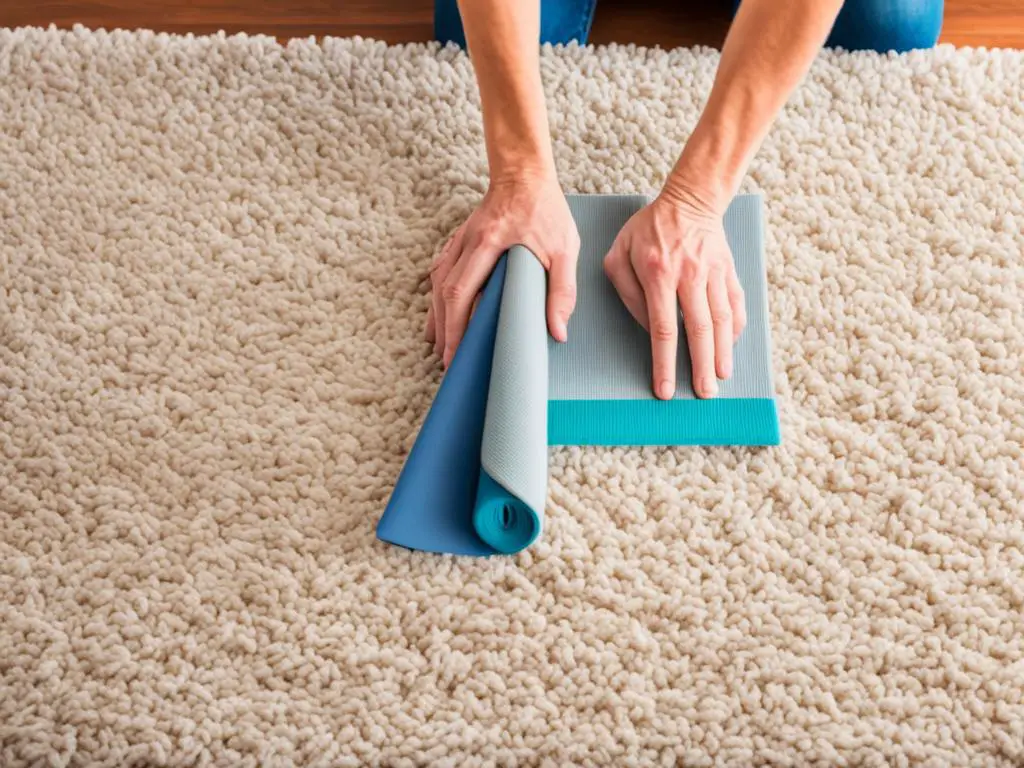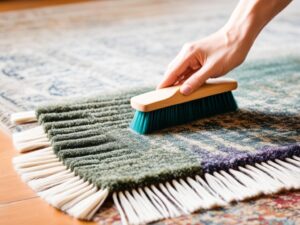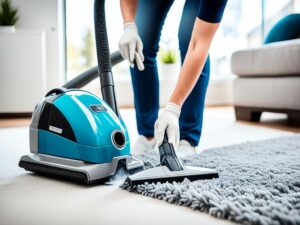Are you tired of dealing with area rug corners that just won’t stay put? We’ve got you covered. In this article, you’ll discover effective methods to keep your area rug corners down, ensuring a safer and neater home environment. Say goodbye to tripping hazards and unsightly rug corners!
Key Takeaways
- Choose the right size rug for your space to prevent rug corners from curling.
- Roll the rug up in the opposite direction and let it rest to help the corners lay flat.
- Expose your rug to sunlight to allow the warmth to relax the fibers and flatten the corners.
- Roll or fold the corners under and let them sit for 24 hours to reverse their course.
- Apply double-sided tape or use rug pads or grippers for added corner stability.
Choose the Right Size Rug for Your Space
The first step in preventing rug corners from curling is to select the appropriate rug size for your space. When a rug is either too small or too large, it may not lie flat, resulting in shifting corners that are prone to curling. To ensure your rug stays in place and the corners remain flat, it is vital to measure your room and choose a rug that is proportional to the space.
Consider the dimensions of the room when selecting a rug. Take into account the furniture layout, traffic flow, and the overall aesthetic you wish to achieve. A rug that is too small for the room can visually appear disconnected and cause the corners to lift and curl. On the other hand, a rug that is too large may extend beyond the furniture and cause the corners to bunch up.
By choosing the right size rug, you create a solid foundation for preventing corner curling and keeping your rug flat and secure.
Here are some tips to choose the right size rug:
- Measure your room accurately, including the furniture area where the rug will be placed.
- Consider the function of the room and the traffic patterns.
- Choose a rug that allows for at least 6 inches of space between the edge of the rug and the walls.
- In dining areas, ensure the rug extends beyond the table and chairs when they are pulled out.
- For living rooms, opt for a rug size that accommodates all furniture legs or at least the front legs.
By following these guidelines, you can select a rug size that not only complements your space but also keeps the corners flat and prevents any curling issues.
| Rug Size | Room Size | Room Layout | Recommended Placement |
|---|---|---|---|
| 5′ x 8′ | Small room or seating area | Furniture resting on or off the rug | Centered under a coffee table or front legs of furniture |
| 8′ x 10′ | Standard-sized living room or bedroom | All furniture legs resting on the rug | Centered under furniture, leaving equal space around the edges |
| 9′ x 12′ | Larger living room or dining room | All furniture legs resting on the rug or dining table and chairs fully on the rug | Centered under furniture or dining set, leaving equal space around the edges |
Choosing the right size rug is an essential factor in keeping rug corners flat and preventing curling. Take the time to measure your space accurately and select a rug that perfectly fits your room, ensuring both style and functionality. By doing so, you will enjoy a rug that remains in place and enhances the overall aesthetic of your home.
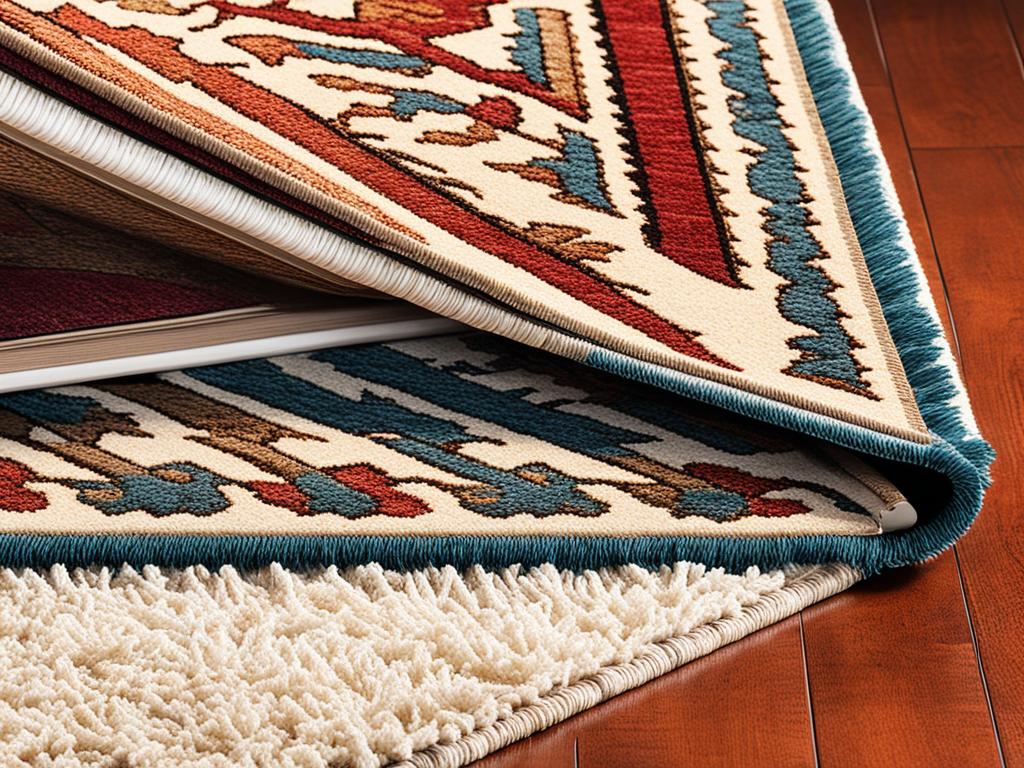
Roll the Rug Up the Opposite Way
If your rug doesn’t want to lay flat when you unroll it, try rolling it up in the opposite direction. Leaving it rolled for a few hours to a few days can allow the carpet fibers to relax and the corners to lay flat.
Rolling the rug up the opposite way can help prevent rug corners from lifting and secure them in place. This method is particularly effective for new rugs that tend to have curled corners due to packaging and transportation.
By rolling your rug in the opposite direction, you are encouraging the corners to flatten out in the opposite direction as well. This technique helps to retrain the rug fibers and counteracts the natural curling tendency.
To roll the rug up the opposite way:
- Gently lift one corner of the rug.
- Starting from the lifted corner, roll the rug tightly in the direction opposite to how it was originally rolled.
- Continue rolling until you reach the opposite corner.
- Secure the rolled rug with straps or ties to prevent it from unraveling.
Allow the rug to stay rolled up for at least a few hours, but preferably a few days, to give the carpet fibers ample time to relax and the corners to flatten. This technique can be especially beneficial for large rugs with persistent corner curling issues.
Remember to unroll the rug slowly and carefully to avoid damaging the corners and edges. With proper rolling and patience, this method can effectively prevent rug corners from lifting and provide a more secure and neat rug placement in your home.
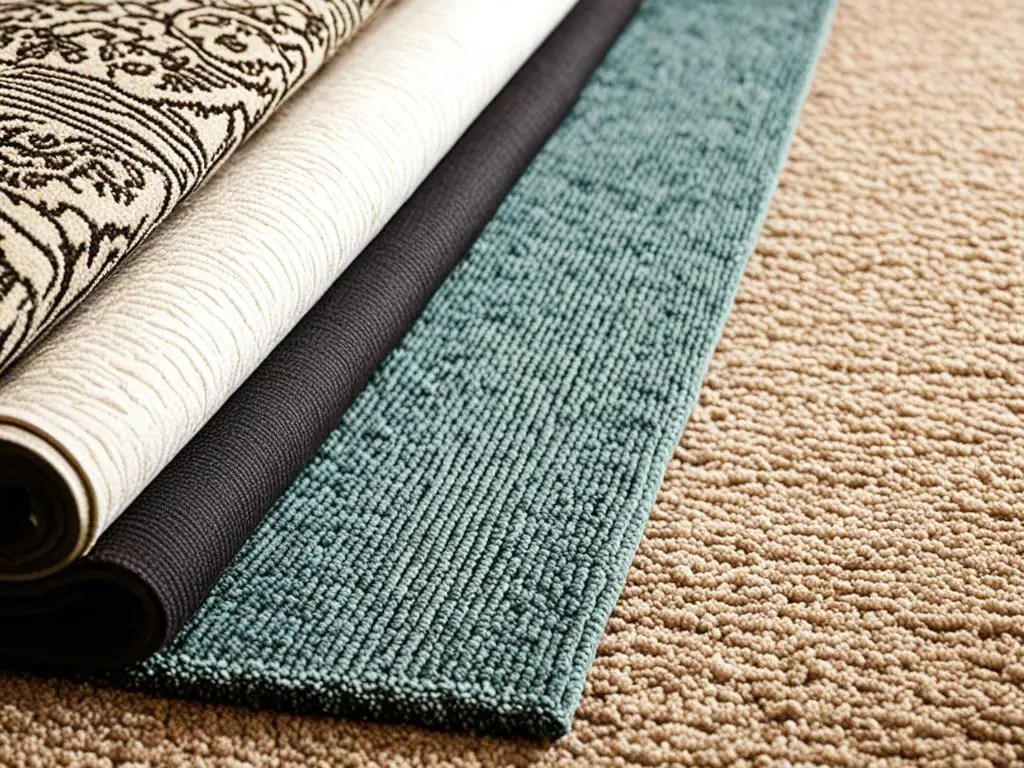
Sit Your Rug Out in the Sun
If your brand-new rug is not sitting flat, here’s a natural solution: put it out in the sun on a nice day.
The warmth from the sun helps relax the rug, allowing lumps and bumps to ease out. It’s a simple and effective tip for flat rug corners. However, it’s important to be cautious on hot days as synthetic fibers and rubber backing can melt.
Let the sun work its magic and watch as your rug regains its smoothness and lays flat.
For more tips and solutions to keep your rug corners flat, continue reading and discover various methods to prevent rug corner issues.
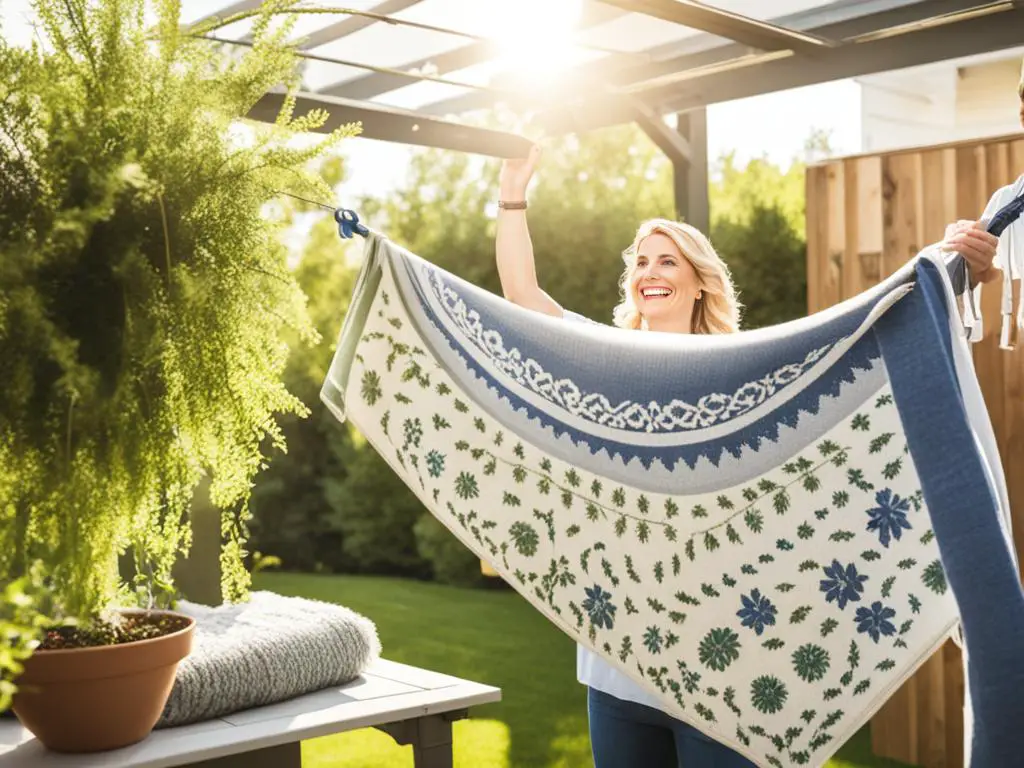
Stay tuned! Here’s a quick sneak peek at the next section:
Even after following the previous tips and methods, if your rug corners are still misbehaving, don’t worry. In the next section, we’ll share an unconventional method that involves rolling or folding the corners. Keep reading to find out how!
Roll or Fold the Corners
For stubborn area rug corners that just won’t stay down, try this handy trick. Roll or fold the corners under and let them sit that way for 24 hours. By manually bending the curled part flat against the floor, you can effectively stop area rug corners from flipping up.
This method works by reshaping the rug fibers and encouraging them to stay in place. It’s a simple yet effective way to reverse the course of unruly corners and keep your rug looking neat and tidy.
Steps to Roll or Fold Rug Corners:
- Gently roll or fold the corner of the rug towards the underside.
- Apply slight pressure to ensure the corner stays in place.
- Leave the folded or rolled corners untouched for at least 24 hours.
- After 24 hours, unroll or unfold the corners and carefully lay the rug back in position.
In most cases, this technique should significantly reduce or eliminate corner flipping. However, keep in mind that it may take a few attempts before the corners fully cooperate. Patience and persistence are key to achieving the desired results.
“Rolling or folding the corners of an area rug can help train them to lie flat and prevent them from flipping up, ensuring a more stable and visually pleasing rug.” – Martha Stewart
By employing this method, you can say goodbye to annoying rug corners that won’t stay put. Remember to follow the steps carefully and give the rug ample time to adjust. Soon enough, you’ll enjoy a beautifully laid-out rug without any flipping corners.
| Advantages | Disadvantages |
|---|---|
| Simple and easy technique | May require multiple attempts |
| No additional tools or accessories needed | Not suitable for all rug types or materials |
| Encourages long-lasting results | Does not address underlying rug size or material issues |
Apply Double-sided Tape
If you’re looking for a quick solution to keep your rug corners in place, consider applying double-sided tape. This simple yet effective method ensures that the rug stays securely anchored to the floor, minimizing the chances of corners curling up. The double-sided tape adheres to both the rug and the floor, creating a strong bond to prevent any unwanted movement.
Before applying the tape, it’s essential to test it in a hidden spot on the rug to check for any potential residue or damage. Once you’ve confirmed that the tape is suitable for your rug and flooring, cut it into small pieces and place them strategically on the problematic corners. Ensure that you press down firmly to maximize adhesion.
“Using double-sided tape is a simple and effective way to keep your rug corners flat and prevent any tripping hazards. It’s a handy tool for securing your rug and maintaining a neat appearance in your living space.”
By using rug corner grippers, you can say goodbye to the frustration of constantly adjusting and readjusting your rug corners. This inexpensive solution offers a strong grip and keeps your rug in place, providing peace of mind and a clean, polished look to your home.
Benefits of Applying Double-sided Tape:
- Prevents rug corners from curling and lifting
- Reduces the risk of tripping hazards
- Ensures a neater and more polished appearance
- Simple and affordable solution
- Compatible with various rug and flooring types
Keep in mind that double-sided tape is a temporary fix and may need to be replaced over time. However, it is a practical option for those who want a hassle-free solution to maintain flat rug corners without making permanent modifications to their rugs or floors.
| Pros | Cons |
|---|---|
| Easy to apply | May leave residue on the floor |
| Affordable | Requires periodic replacement |
| Does not permanently alter rugs or floors | May not be suitable for all rug and flooring types |
Use Rug Pads or Grippers
When it comes to keeping your rug corners flat, rug pads and grippers are your secret weapons. These simple yet effective solutions provide the necessary grip and stability to prevent your rug from sliding or curling up at the corners. Whether you have an area rug on top of carpet or hardwood floors, rug pads and grippers can make a noticeable difference in keeping your rugs in place.
Rug pads are particularly useful as they offer a cushioning effect while keeping your rug securely anchored. They create a barrier between the rug and the floor, preventing any movement and helping to maintain a flat surface. Rug pads come in various materials, such as felt, rubber, or a combination of both. Choose the right pad depending on your floor type and personal preference.
If you’re dealing with stubborn rug corners that need extra reinforcement, rug grippers are an excellent solution. These small adhesive strips can be applied to the corners of your rug, providing additional control and preventing any lifting or curling. Rug grippers are especially beneficial for high-traffic areas where rugs are more prone to shifting and movement.
“Using rug pads and grippers is a simple yet effective way to keep your rug corners flat and secure.”
By investing in rug pads or grippers, you can enjoy the peace of mind that comes with a rug that stays in place, preventing tripping hazards and maintaining a clean, polished look. Explore the different options available and choose the one that best suits your rug and flooring type.
| Rug Corner Solution | Benefits |
|---|---|
| Rug Pads | Provides grip and prevents sliding |
| Rug Grippers | Extra control and prevention of lifting or curling |
Conclusion
Keeping your area rug corners down is vital for maintaining a safe and visually appealing home. By implementing the following methods – choosing the right size rug, rolling the rug up in the opposite direction, securing with double-sided tape, and utilizing rug pads or grippers – you can effectively prevent rug corners from curling and create a neater living space.
Start by ensuring that you select a rug that is proportionate to your space. A well-fitted rug will lie flat and minimize the chances of corners shifting. Additionally, rolling the rug up in the opposite direction and allowing it to rest for a few hours or even a few days will help the carpet fibers relax and the corners to lay flat.
For stubborn corners, try rolling or folding them under and leaving them that way for 24 hours. This manual adjustment will encourage the corners to reverse course and remain flat. Alternatively, applying double-sided tape to the corners can provide a quick and effective solution. Just make sure to test the tape in a hidden spot first to avoid any potential residue or damage.
Rug pads or grippers are also valuable tools in keeping your rug corners down. These non-slip accessories provide grip and prevent sliding, especially on carpeted or hardwood floors. By experimenting with these various methods, you can find the best solution for your specific rug and flooring type, ultimately allowing you to enjoy your rug without the worry of tripping hazards or unsightly corners.
